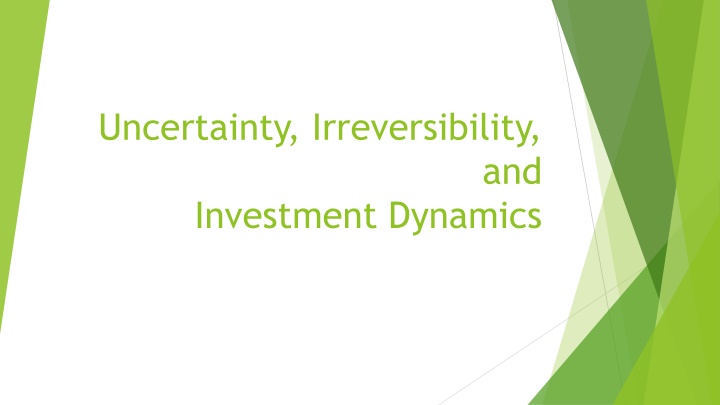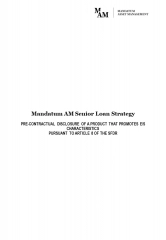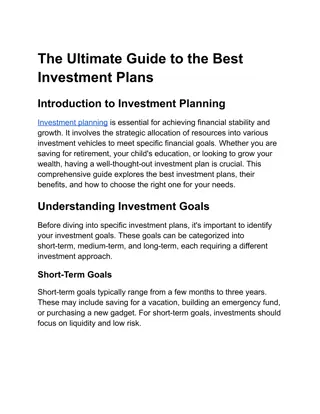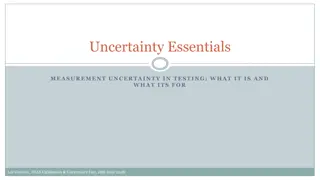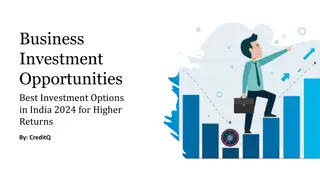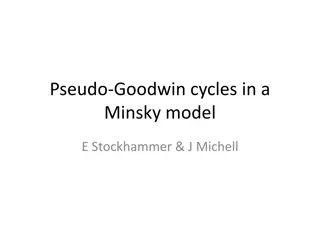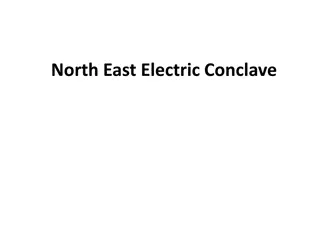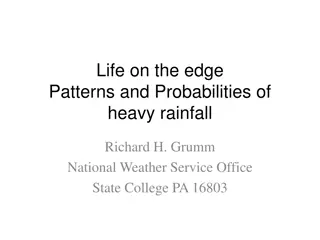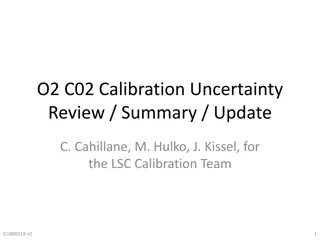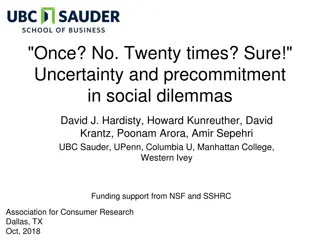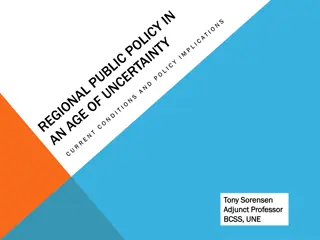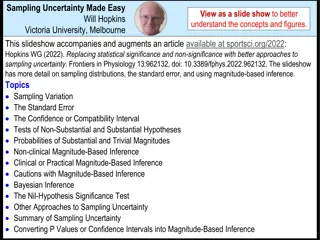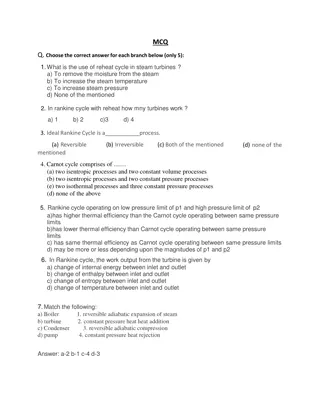Investment Dynamics and Uncertainty in Business Cycles
Aggregate investment spending plays a crucial role in economic fluctuations during business cycles. Uncertainty and irreversibility influence firms' investment decisions, leading to significant cyclical movements. Research indicates that uncertainty can enhance the attractiveness of investment by increasing the value of capital. Understanding and measuring irreversibility in capital goods present challenges but are critical for evaluating investment behavior.
Download Presentation

Please find below an Image/Link to download the presentation.
The content on the website is provided AS IS for your information and personal use only. It may not be sold, licensed, or shared on other websites without obtaining consent from the author.If you encounter any issues during the download, it is possible that the publisher has removed the file from their server.
You are allowed to download the files provided on this website for personal or commercial use, subject to the condition that they are used lawfully. All files are the property of their respective owners.
The content on the website is provided AS IS for your information and personal use only. It may not be sold, licensed, or shared on other websites without obtaining consent from the author.
E N D
Presentation Transcript
Uncertainty, Irreversibility, and Investment Dynamics
Aggregate investment spending is an important source of fluctuations over the business cycle A puzzling aspect of such fluctuations is that they sometimes occur in connection with relatively small shocks or policy impulses an alternative mechanism that may explain the observed large cyclical movements of investment with respect to the business cycle, based on the firms behavior under uncertainty In the last decade, research has focused on a class of models in which real options influence investment behavior, since firms may have an incentive to wait for the arrival of new information, thus postponing the implementation of their investment plans
Early contributions have shown that uncertainty may increase the value of the marginal unit of capital, thus leading to more capital accumulation Hartman (1972) and Abel (1983) investigate the impact of uncertainty on capital accumulation by focusing on the investment behavior of a competitive firm with constant returns to scale and (symmetric) convex adjustment costs Under these assumptions the resulting profit function is convex in price and, therefore, a mean-preserving increase in price uncertainty raises the expected return on a marginal unit of capital under the Jensen s inequality, therefore enhancing the attractiveness of additional investment
How to define and measure irreversibility A thorough study of the relevant theoretical and empirical literature reveals that there exist a multitude of irreversibility definitions Moreover, the degree of irreversibility of capital goods has confronted researchers with a rather thorny task when it comes to its empirical measurement Chronologically, the first definition of irreversibility was technology-based, linking irreversibility to the ability of the decision-maker (firm, sector) to substitute between capital and labour (Hartman, 1972, 1976) This notion relates to the characteristics of the production technology employed and suggests that shocks rendering a priori choices of capital sub-optimal ex post, may be absorbed by appropriately adjusting labour (the variable production input) As is apparent, the adverse impact of a given shock is lessened as the degree of substitutability between labour and capital increases
A descendant of this view is the study of Lee and Shin (2000) who emphasise the share of labour in production as a further factor accentuating the negative effect of uncertainty under irreversibility The second definition of irreversibility is transactions-based and views irreversibility as a friction affecting the decision-maker s ability to undo capital commitments per se and takes the form of a price differential between buying ( p+) and selling ( p ) prices for capital (Abel and Eberly, 1996; Chirinko and Schaller, 2002) Basically, the degree of irreversibility (or sunkness) of capital is a function of the price ratio (or differential)
However, although buying prices maybe observable in empirical applications, this is not generally true for selling prices. In order to overcome this unobservability the literature has devised various indirect observable indicators that may reflect the degree of irreversibility in terms of transactions-based friction For instance, the share of sunk outlays ( sunkness ) is likely to be low in industries using capital that can be easily leased (Kessides, 1990), or using capital for which an active second-hand market exists (Kessides, 1990; Worthington, 1995)
In other words, the intensities of the rental and resale markets in an industry could be viewed as proxies for the mobility and transferability of the capital employed in the industry Kessides goes even further, stating that the intensity of the resale market may be viewed as an indicator of the capital s specificity Capital that is industry, rather than firm-specific, may be sold by exiting enterprises to other firms in the industry, thus giving rise to an active second- hand market In contrast, capital that is expensive to convert into alternative uses once it has been relegated to a specific form, will not readily lend itself to resale Similarly, if the capital employed is mostly firm-specific, or very expensive to relocate, then it is unlikely that an active rental market will exist in the industry
The empirical literature has also used another indirect measure for the degree of irreversibility in the transactions-based concept In particular, the ratio of disposals (selling capital) to acquisitions (capital purchases) is used as an indicator of the activity of second-hand markets and, consequently, of reversibility. Clearly, the ratio will be low, or approaching zero, if second hand markets were thin or non-existent (Driver et al., 2006) Finally, some researchers have proposed an indirect indicator for the degree of irreversibility by resorting to an ad hoc ordering of irreversibility, where the researcher a priori orders capital goods based on their underlying characteristics, and therefore, depending on the user s exposure to each asset type, one may infer the degree of irreversibility (Guiso and Parigi, 1999; Goel and Ram, 1999, 2001; Butzen et al., 2002; Driver et al., 2006; Bulan, 2005; Drakos, 2006)
How investment behaves under irreversibility Importantly, the (symmetric) convexity of adjustment costs rules out the possibility that investment expenditures irreversibility, a feature first emphasized by Arrow (1968) When investment is completely irreversible and future demand, cost conditions and other relevant market variables are uncertain, firms have an incentive to wait until more information becomes available On the contrary, when a firm does invest it gives up the possibility of waiting for new information to arrive that might affect the desirability or timing of the expenditure; it cannot disinvest should market conditions change adversely (Dixit and Pyndick 1994) In other words, the implementation of a given investment plan carries an opportunity cost equivalent to the exercise of a financial call option and the decision to exercise such an option is irreversible In fact, although the holder may sell the asset at a later stage, she will not be able to recover the money paid for exercising the option may exhibit some degree of
Caballero (1991) investigates the impact of uncertainty and irreversibility on investment, highlighting the role that different assumptions on the functional form of adjustment costs and on the degree of competition and returns to scale play in shaping the response of investment to uncertainty Interestingly, he shows that if we move away from the hypothesis of perfect competition and constant returns to scale towards one of imperfect competition or decreasing returns to scale, the response of investment to uncertainty becomes negative In this setting, Caballero also shows that the more asymmetric the functional form of adjustment costs is, the more negative the relationship between investment and uncertainty becomes
Investment Dynamics Under Irreversibility and Uncertainty Previous theoretical literature has established that irreversibility of capital creates an embedded call option in investment decisions that leads to a modification of the standard net present value (NPV) rule or the q-theory (McDonald and Siegel 1986; Pindyck 1988; Dixit and Pindyck 1994) In particular, in ambivalent environments, investment is triggered at a higher threshold compared to the simple NPV case Similalrly positive investment becomes optimal after exceeding a multiple of q, the size of which is known as irreversibility premium (see Chirinko and Schaller 2002) Hence decision-makers may find inactivity as being optimal in certain situations until uncertainty is partly resolved (more information is revealed), known as a wait-and-see strategy Along similar lines, Abel and Eberly (1994, 1996) have shown that irreversibility and fixed adjustment costs lead to a non-continuous investment policy that includes an inaction zone
Moreover, like in standard financial option contracts, the option of waiting becomes more valuable as uncertainty increases In the business fixed investment literature terminology, increased uncertainty raises the investment trigger threshold thereby extending the inaction zone Thus uncertainty has a negative impact on business fixed investment spending by discouraging or postponement of investment
Abel and Eberly (1999) and Bloom (2000) emphasize that, with partial irreversibility, a higher level of uncertainty implies both a higher threshold rate of return to justify positive investment, and a lower threshold required rate of return to justify disinvestment As the optimal investment policy is characterized by a wider threshold rule, these two factors unambiguously reduce the short-term response of investment to exogenous demand shocks
The main body of the previous mentioned literature has dealt with a single capital good or treated multiple capital goods as homogeneous Eberly (1997) spurred the literature studying the investment uncertainty relationship with multiple (heterogeneous) capital goods Essentially, she showed that in the presence of multiple capital goods, a firm s overall investment rate is decomposed into the extensive margins (the number of capital goods a firm invests in) and the intensive margins (the investment expenditure per type of capital good) Eberly and van Mieghem (1997) revisited the case of multifactor investment, demonstrating that the optimal investment decisions would follow a multidimensional threshold policy. However, their intuitive analysis was restricted to constant level of uncertainty, thereby producing static cross- sectional conclusions.
Bloom et al. (2007), retaining the heterogeneous capital setup but allowing for time-varying uncertainty, illustrated that the response of investment to demand shocks tends to be convex, as larger (smaller) shocks induce firms to invest in more (fewer) types of capital and at more (fewer) production units. Among other conclusions, they show that variations in uncertainty are mapped to variations in both the extensive and intensive margins
Thus the main prediction of Eberly and van Mieghem (1997) and Bloom et al. (2007) is that higher uncertainty reduces the extensive margin Let us provide some more intuition about the underlying mechanism. A core assumption is that capital goods are heterogeneous, at least in terms of their underlying degrees of irreversibility This gives rise to type-of-capital specific trigger thresholds above which positive investment is optimal for each type Then if one considers an ordering of the type-specific trigger thresholds, the number of capital types for which positive investment is optimal is given by the number of capital types exceeding their own trigger threshold
For instance, one may consider extremely large levels of uncertainty (that make the option of waiting very valuable) resulting in no capital good exceeding its own trigger threshold The other extreme would be a situation where uncertainty is so low that the option value of waiting for every type of capital good is nullified, and consequently all capital goods exceed their own threshold Between these two extremes, it becomes apparent that as uncertainty increases (decreases), the likelihood of more capital types exceeding their own threshold decreases (increases), thus producing the negative impact of uncertainty on the extensive margin
References Abel, A. and Eberly, J. (1996) Optimal investment with costly reversibility , Review of Economic Studies, Vol. 63, pp.581 594. BLOOM, N., BOND, S. and VAN REENEN, J. (2007). Uncertainty and investment dynamics. Review of Economic Studies, 74(2), 391 415. Chirinko, R. and Schaller, H. (2002) The Irreversibility Premium, Carleton University, Working Paper. Drakos, K. (2006) A note on uncertainty and investment across the spectrum of irreversibility , Applied Economics Letters, Vol. 13, No. 20, pp.877 880. Drakos, K. Testing Uncertainty s Effect in Real Options Theory with Multiple Capital Goods , Economica, 78, 330-346, 2011.
Driver, C., Temple, P. and Urga, G. (2006) Contrasts between classes of assets in fixed investment equations as a way of testing real option theory , Journal of Business and Economic Statistics, Vol. 24, No. 4, pp.432 443. Kessides, I. (1990) Market concentration, contestability, and sunk costs , Review of Economics and Statistics, Vol. 72, No. 4, pp.614 622. Lee, J. and Shin, K. (2000) The role of a variable input in the relationship between investment and uncertainty , American Economic Review, Vol. 90, No. 3, pp.667 680.
